| (2 révisions intermédiaires par 2 utilisateurs non affichées) | |||
| Ligne 1 : | Ligne 1 : | ||
| − | {{ | + | {{Tuto Details |
|Main_Picture=Tawashi_53723707_268554654073514_828667975023198208_n.jpg | |Main_Picture=Tawashi_53723707_268554654073514_828667975023198208_n.jpg | ||
|Licences=Attribution (CC BY) | |Licences=Attribution (CC BY) | ||
| − | |Description=<translate>This tutorial aims to provide another life to your old cloth or pieces of cloth by doing an eco-friendly sponge.</translate> | + | |Description=<translate><!--T:1--> |
| + | This tutorial aims to provide another life to your old cloth or pieces of cloth by doing an eco-friendly sponge.</translate> | ||
|Area=Hygiene | |Area=Hygiene | ||
|Type=Tutorial | |Type=Tutorial | ||
| Ligne 15 : | Ligne 16 : | ||
|IsTranslation=0 | |IsTranslation=0 | ||
}} | }} | ||
| − | {{ | + | {{Introduction |
| − | |Introduction=<translate>Think of putting aside your damaged cloth to give them a second life. You can even do it from a thread of fabric too. Then you'll be able to use it for washing your dish or yourself depending of the material you use. A soft material like cotton is good for the body, t-shirt also works, only jeans and pants are not recomendable.</translate> | + | |Introduction=<translate><!--T:2--> |
| + | Think of putting aside your damaged cloth to give them a second life. You can even do it from a thread of fabric too. Then you'll be able to use it for washing your dish or yourself depending of the material you use. A soft material like cotton is good for the body, t-shirt also works, only jeans and pants are not recomendable.</translate> | ||
}} | }} | ||
| − | {{ | + | {{TutoVideo |
|VideoType=Youtube | |VideoType=Youtube | ||
|VideoURLYoutube=https://www.youtube.com/watch?v=JkhjI7srH_8&feature=youtu.be | |VideoURLYoutube=https://www.youtube.com/watch?v=JkhjI7srH_8&feature=youtu.be | ||
}} | }} | ||
| − | {{ | + | {{Materials |
|Step_Picture_00=Tawashi_tawashi-5.jpg | |Step_Picture_00=Tawashi_tawashi-5.jpg | ||
| − | |Material=<translate>Old thick stockings, tights or socks | + | |Material=<translate><!--T:3--> |
| + | Old thick stockings, tights or socks | ||
| + | <!--T:4--> | ||
Old cloth</translate> | Old cloth</translate> | ||
| − | |Tools=<translate>A wooden board (at least 16-20cm per side) | + | |Tools=<translate><!--T:5--> |
| + | A wooden board (at least 16-20cm per side) | ||
| + | <!--T:6--> | ||
20 nails | 20 nails | ||
| + | <!--T:7--> | ||
scissors | scissors | ||
| + | <!--T:8--> | ||
a hammer | a hammer | ||
| + | <!--T:9--> | ||
a pencil | a pencil | ||
| + | <!--T:10--> | ||
a ruler</translate> | a ruler</translate> | ||
}} | }} | ||
| − | {{ | + | {{Tuto Step |
| − | |Step_Title=<translate>Create the weaving loom</translate> | + | |Step_Title=<translate><!--T:11--> |
| − | |Step_Content=<translate>Use your pencil and ruler to draw a square 12cmx12cm. | + | Create the weaving loom</translate> |
| + | |Step_Content=<translate><!--T:12--> | ||
| + | Use your pencil and ruler to draw a square 12cmx12cm. | ||
| + | <!--T:13--> | ||
Put 20 nails every 2 cm. With your hammer, firmly plant the nails into the board onto each of the 20 dots.</translate> | Put 20 nails every 2 cm. With your hammer, firmly plant the nails into the board onto each of the 20 dots.</translate> | ||
|Step_Picture_00=Tawashi_54175220_649893805443131_5862535173974786048_n.jpg | |Step_Picture_00=Tawashi_54175220_649893805443131_5862535173974786048_n.jpg | ||
}} | }} | ||
| − | {{ | + | {{Tuto Step |
| − | |Step_Title=<translate>Prepare the cloth</translate> | + | |Step_Title=<translate><!--T:14--> |
| − | |Step_Content=<translate>Choose a sock that can stretch over 12 cm. | + | Prepare the cloth</translate> |
| + | |Step_Content=<translate><!--T:15--> | ||
| + | Choose a sock that can stretch over 12 cm. | ||
| + | <!--T:16--> | ||
Use your scissors to cut 10 rings of 4 cm width on your socks.</translate> | Use your scissors to cut 10 rings of 4 cm width on your socks.</translate> | ||
|Step_Picture_00=Tawashi_53719198_263022237934887_2274742326389637120_n.jpg | |Step_Picture_00=Tawashi_53719198_263022237934887_2274742326389637120_n.jpg | ||
}} | }} | ||
| − | {{ | + | {{Tuto Step |
| − | |Step_Title=<translate>Attach the rings</translate> | + | |Step_Title=<translate><!--T:17--> |
| − | |Step_Content=<translate>Attach the rings to the nails vertically, only in one side. | + | Attach the rings</translate> |
| + | |Step_Content=<translate><!--T:18--> | ||
| + | Attach the rings to the nails vertically, only in one side. | ||
| + | <!--T:19--> | ||
Attach 5 rings vertically (see image).</translate> | Attach 5 rings vertically (see image).</translate> | ||
}} | }} | ||
| − | {{ | + | {{Tuto Step |
| − | |Step_Title=<translate>Weave</translate> | + | |Step_Title=<translate><!--T:20--> |
| − | |Step_Content=<translate>Weave the remaining 5 rings horizontally in and out of the vertical rings. Start by attaching a ring to the top left nail on the left side of the square and pass it over the first vertical ring, under the second vertical ring, over, under and over and then hook it to the opposite top right nail on the right side of the square. Attach 4 more rings horizontally, but weaving the opposite way with each new ring: Horizontal rings 2 and 4 would be under, over, under, over, under. (see image).</translate> | + | Weave</translate> |
| + | |Step_Content=<translate><!--T:21--> | ||
| + | Weave the remaining 5 rings horizontally in and out of the vertical rings. Start by attaching a ring to the top left nail on the left side of the square and pass it over the first vertical ring, under the second vertical ring, over, under and over and then hook it to the opposite top right nail on the right side of the square. Attach 4 more rings horizontally, but weaving the opposite way with each new ring: Horizontal rings 2 and 4 would be under, over, under, over, under. (see image).</translate> | ||
|Step_Picture_00=Tawashi_53533134_279050053016600_4557761926637027328_n.jpg | |Step_Picture_00=Tawashi_53533134_279050053016600_4557761926637027328_n.jpg | ||
}} | }} | ||
| − | {{ | + | {{Tuto Step |
| − | |Step_Title=<translate>Close the loops</translate> | + | |Step_Title=<translate><!--T:22--> |
| − | |Step_Content=<translate>Unhook any ring/loop from its nail, then unhook a second loop right next to it. Pass the second loop into the first loop. Hold on to the second loop and let go of the first loop. The second loop now becomes the “first loop”. Continue this step all around your square. Tighten as you go, as needed. | + | Close the loops</translate> |
| + | |Step_Content=<translate><!--T:23--> | ||
| + | Unhook any ring/loop from its nail, then unhook a second loop right next to it. Pass the second loop into the first loop. Hold on to the second loop and let go of the first loop. The second loop now becomes the “first loop”. Continue this step all around your square. Tighten as you go, as needed. | ||
| + | <!--T:24--> | ||
The final loop that you end up with is the hook that you’ll use to hang and dry your tawashi sponge!</translate> | The final loop that you end up with is the hook that you’ll use to hang and dry your tawashi sponge!</translate> | ||
|Step_Picture_00=Tawashi_DSC_2212.JPG | |Step_Picture_00=Tawashi_DSC_2212.JPG | ||
}} | }} | ||
| − | {{ | + | {{Notes |
|Notes=<translate></translate> | |Notes=<translate></translate> | ||
}} | }} | ||
| − | {{ {{ | + | {{PageLang |
| + | }} | ||
| + | {{Tuto Status | ||
|Complete=Published | |Complete=Published | ||
}} | }} | ||
| − | {{ | + | {{Separator}} |
Version actuelle datée du 31 octobre 2019 à 10:16
Description
This tutorial aims to provide another life to your old cloth or pieces of cloth by doing an eco-friendly sponge.
Introduction
Youtube
Étape 1 - Create the weaving loom
Use your pencil and ruler to draw a square 12cmx12cm.
Put 20 nails every 2 cm. With your hammer, firmly plant the nails into the board onto each of the 20 dots.
Étape 2 - Prepare the cloth
Choose a sock that can stretch over 12 cm.
Use your scissors to cut 10 rings of 4 cm width on your socks.
Étape 3 - Attach the rings
Attach the rings to the nails vertically, only in one side.
Attach 5 rings vertically (see image).
Étape 4 - Weave
Weave the remaining 5 rings horizontally in and out of the vertical rings. Start by attaching a ring to the top left nail on the left side of the square and pass it over the first vertical ring, under the second vertical ring, over, under and over and then hook it to the opposite top right nail on the right side of the square. Attach 4 more rings horizontally, but weaving the opposite way with each new ring: Horizontal rings 2 and 4 would be under, over, under, over, under. (see image).
Étape 5 - Close the loops
Unhook any ring/loop from its nail, then unhook a second loop right next to it. Pass the second loop into the first loop. Hold on to the second loop and let go of the first loop. The second loop now becomes the “first loop”. Continue this step all around your square. Tighten as you go, as needed.
The final loop that you end up with is the hook that you’ll use to hang and dry your tawashi sponge!
Published
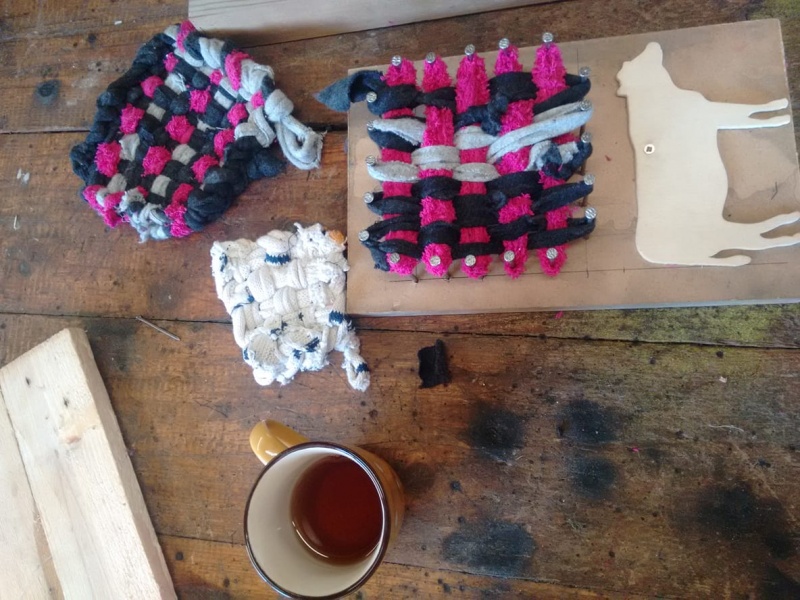
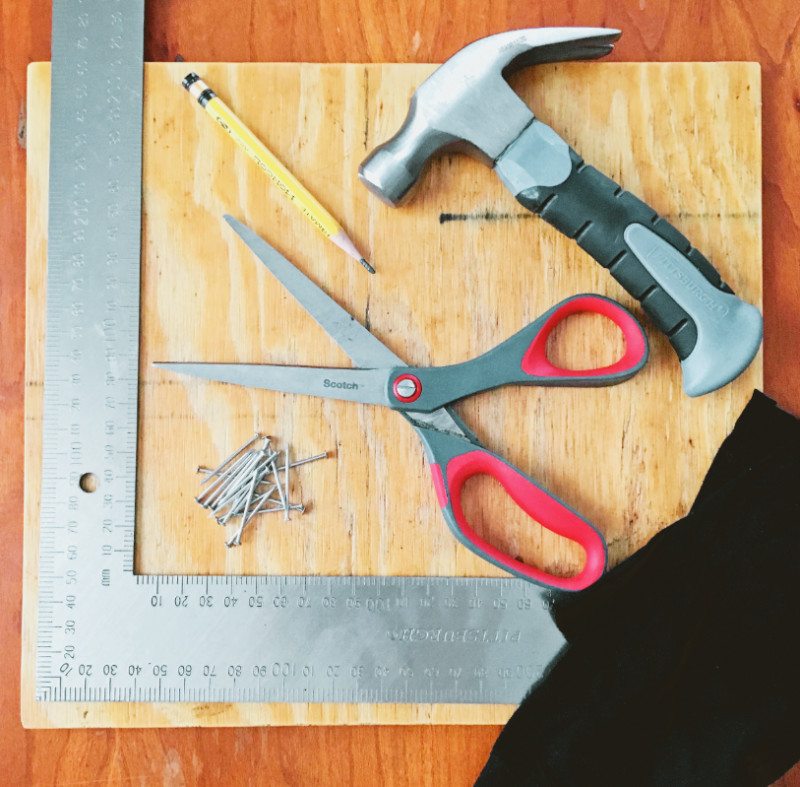
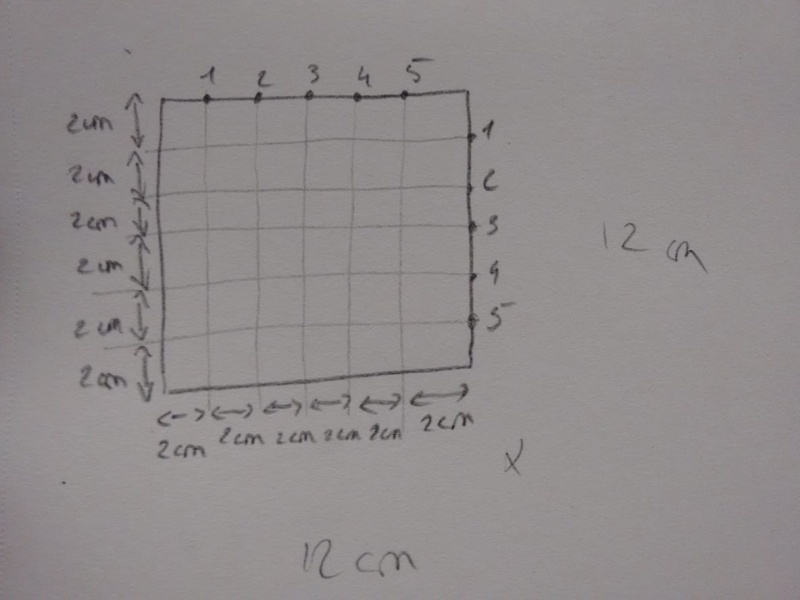
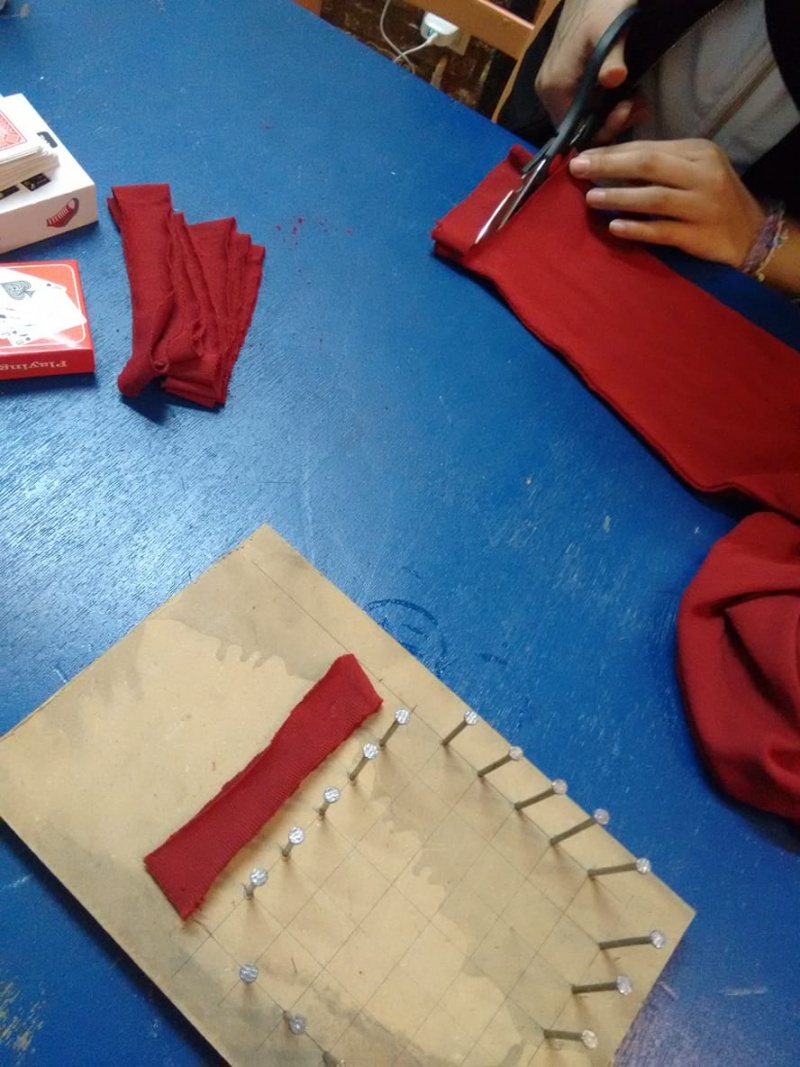
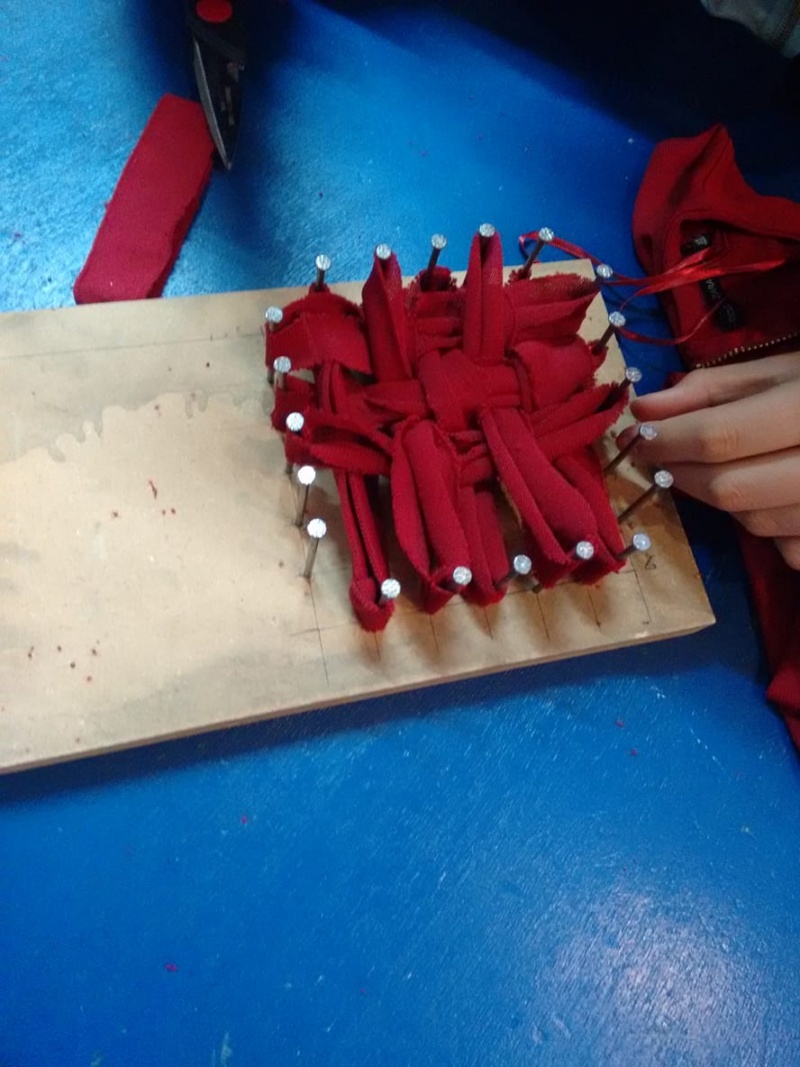
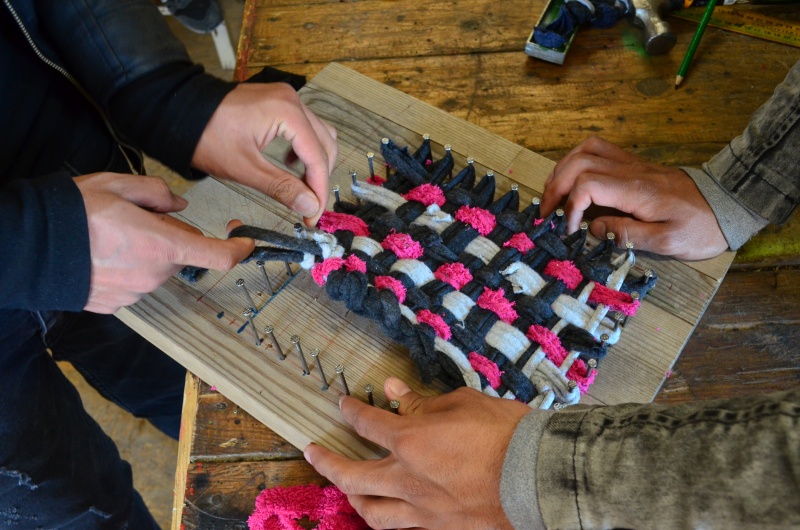
 Français
Français English
English Deutsch
Deutsch Español
Español Italiano
Italiano Português
Português